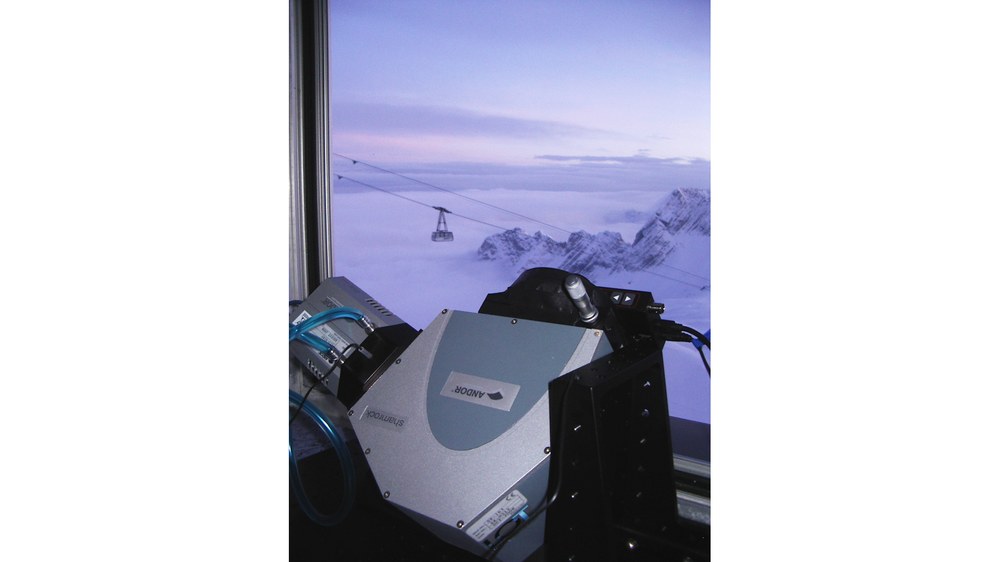15 Years of Measurements at Schneefernerhaus
For 15 years EOC has been measuring the temperature of the mesopause at ca. 90 kilometres altitude from the Schneefernerhaus environmental research station (UFS) on the Zugspitze. On July 1, 2009, the first GRIPS (GRound-based Infrared P-branch Spectrometer) instrument went into operation there. GRIPS records airglow, night after night. Airglow is a natural light emission and its spectral signature can be used to determine the temperature at that altitude. This measurement method is one of the few low-cost ways to collect data about this little-researched altitude range.
The first measurements with the prototype of a new spectrometer were made at UFS on October 25, 2008, as part of the SCARAMANGA measurement campaign (Search for Characteristic Airglow Response to Autumnal Meteoroid showers during Nocturnal Gauging of the Atmosphere). The results obtained were so promising that little more than half a year later these measurements could be carried out fully automatically and since then they are available for scientific analysis.
From the beginning, the emphasis was on the aspect of applications for the German Remote Sensing Data Center (DFD). Accordingly, the development of the first prototype, "GRIPS 5", took place in the context of DLR participation in the German-Indonesian Tsunami Early Warning System (GiTEWS). This undertaking investigated whether the measurements that at that time had a temporal resolution of only 3 to 5 minutes could be improved to the extent that infrasound monitoring was possible. Infrasound is, like sound, an acoustic wave – although with a frequency below human audibility. Pitch A with a frequency of 440 Hz is an acoustic wave whose signature repeats 440 times per second, the auditory threshold being ca. 16 repetitions per second (16 Hz). The frequency range of infrasound extends from that threshold to about 0.003 Hz (a repetition rate of five minutes). Among other source it is generated by tsunamis on the open sea, and its timely detection over the open sea (e.g., in the airglow using remote sensing methods) can contribute to distinguishing whether strong submarine earthquakes give rise to a tsunami or not. This work led in 2022 to the establishment of a measuring station on the South American coast of Chile, where at the same altitude as at UFS – about 2650 m – the latest "GRIPS 19" measurement systems and a few years later also FAIM (Fast Airglow IMAger) systems monitor with a temporal resolution of up to one second (see the link to OASIS-News).
The high number in the designation "GRIPS 19" says it all: the development of "GRIPS 5" represents a milestone in monitoring airglow. Not only has DFD itself operated 15 of these instruments for many years at locations from A for Abastumani (Georgia) to N for Neumayer III (Antarctica) to Z for Zugspitze. There are also unnamed copies of GRIPS being operated by other research groups worldwide, from Norway to China. Their excellent reliability also makes them a popular instrument for long-term monitoring of the mesopause temperature. Therefore, it is now the standard instrument in the Network for the Detection of Mesospheric Change (NDMC). Originally in the early 2000s the assumption was that "potential" climate change could definitely be detected in the mesopause region earlier than at ground level. However, the measurements from the various instruments did not provide unambiguous results. This was also due to the many different systems being used for the measurements. Now thanks to measurements with GRIPS, data from many locations worldwide are now easier to compare. While climate change in the troposphere has long been scientifically confirmed, the measurements in the mesopause still clearly differ, although no longer to the extent they did 20 years ago. This is further evidence that fundamental processes going on in the middle atmosphere are still not adequately understood.
A look into the future: In view of the recently announced so-called "New Space" era with rocket and satellite launches in previously unimaginable numbers, the combustion products of the rocket fuel on the one hand and the metals from satellite burning up as they re-enter Earth's middle atmosphere on the other hand, likewise to unknown extent, the question arises of what that means for the atmosphere. So these measurements, which began a good ten years before the beginning of the New Space era, gain even more importance for monitoring the influence of humans on the basis of their own livelihood.




